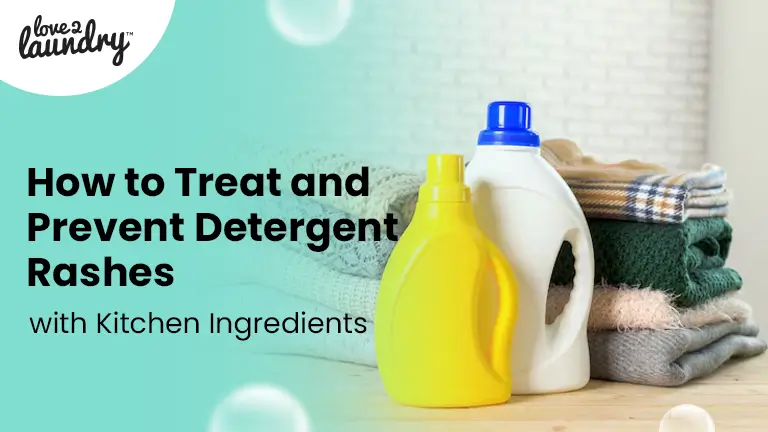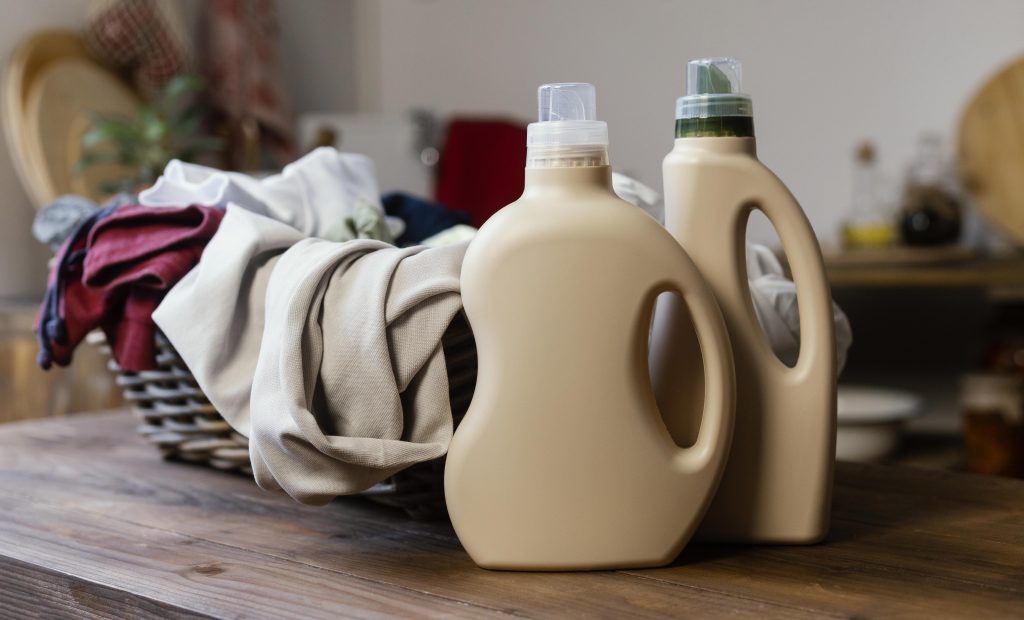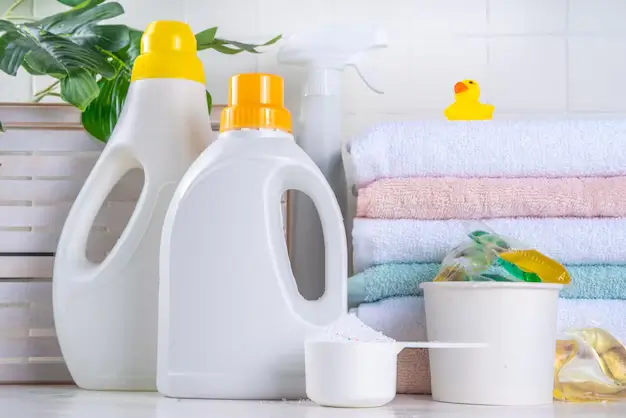How to Treat and Prevent Detergent Rashes with Kitchen Ingredients

Detergent rashes are a surprisingly common predicament, affecting countless individuals who simply want clean clothes. While they can be incredibly uncomfortable and even frustrating, these pesky skin irritations are often easily treatable and preventable.
A detergent rash, also known as contact dermatitis, occurs when your skin reacts to irritating chemicals or allergens present in laundry detergents. This can happen in two ways: an irritant reaction, where harsh chemicals directly damage the skin, or an allergic reaction, where your immune system overreacts to a specific ingredient.
Fragrances, dyes, and preservatives are common culprits behind the dreaded washing detergent rash, leaving your skin feeling anything from slightly irritated to intensely inflamed. In this blog, we’ll explore these simple yet powerful solutions that are kind to your skin and your wallet.
But prevention is always preferable to treatment. Adopting a skin-friendly laundry practice is essential to preventing future flare-ups, even while home cures can provide momentary relief. Love2Laundry can help you by taking this chore from your hands.
Our professional laundry and dry cleaning service utilizes high-quality and gentle products with processes designed to be kind to your clothes and your skin, while also sharing expert tips for keeping your clothes fresh every day

Step 1: Understand What a Detergent Rash Is
A rash from detergent happens when certain chemicals, fragrances, or residues in laundry products irritate the skin. Just like learning how to remove tea stains from clothes, choosing the right detergent can help prevent redness, itching, or small bumps on sensitive skin..
Knowing the cause helps you choose safer washing methods, like learning how to use laundry sanitiser properly, to keep clothes clean without triggering irritation.
Allergic Detergent Rash
- Triggered by an immune system reaction to detergent chemicals.
- Caused by fragrances, dyes, or preservatives.
- It appears as red, itchy patches on the skin.
- Often develops hours after contact.
- It can spread beyond the direct contact area.
- Symptoms include swelling and small blisters.
- Requires avoidance of the allergen.
- May need antihistamines or medicated creams.
Irritant Detergent Rash
- It is caused by direct chemical damage to the skin.
- Harsh ingredients strip natural skin oils.
- Symptoms are dryness, redness, and itching.
- Usually affects exposed contact areas only.
- It can occur immediately after washing.
- Not an immune response, just skin barrier damage.
- Worse with frequent exposure or residue.
- Improves by switching to gentle and mild detergents.
Step 2: Recognise the Symptoms Early
Early detection of a detergent rash’s symptoms can help prevent the illness from worsening. Redness, itching, dryness, and tiny bumps on places that come into direct contact with clothing are the most typical symptoms.
In more extreme situations, you might experience burning, blistering, or swelling that makes the skin touch-sensitive. Keep in mind that laundry detergent pods’ concentrated formula may cause more severe reactions, especially in those with sensitive skin.
You can stop using the suspected product before the rash spreads further. To avoid recurring flare-ups, many people explore natural alternatives to laundry detergent that are free from harsh chemicals and still powerful enough to remove oil stains from clothes Monitoring even the most minor changes on your skin helps you act quickly and reduce discomfort. Taking these steps ensures healthier, irritation-free laundry care and makes the most of professional laundry services in the long run.
Step 3: Treat Detergent Rashes with Kitchen Ingredients
You can easily treat your detergent rashes with kitchen materials. Here’s what you can use:
Oatmeal Paste or Bath
- Soothes itchy detergent rashes naturally.
- Reduces inflammation and redness on the skin.
- Oatmeal forms a protective barrier over rashes.
- Can be added to lukewarm bath water.
- Works well for sensitive skin relief.
- Provides gentle hydration to dry patches.
- Best used daily for quicker recovery.
- Helps calm irritation caused by laundry detergent allergies.
Aloe Vera Gel
- Cools and soothes laundry detergent rash.
- Rich in anti-inflammatory properties.
- Promotes faster skin healing.
- Hydrates and reduces dryness.
- It can be applied directly to the affected skin.
- Safe for repeated daily application.
- Helps relieve burning and itching sensations.
- Natural option for calming sensitive skin.
Baking Soda Solution
- Neutralises itching from detergent rashes.
- Acts as a mild antiseptic and cleanser.
- Restores skin’s pH balance naturally.
- Mix with water to form a smooth paste.
- Apply gently to the rash for quick relief.
- Avoid overuse to prevent excess dryness.
- Works as part of laundry hacks with baking soda and vinegar.
- Helps reduce discomfort from rash flare-ups.
Cold Milk Compress
- Soothes redness and itching instantly.
- Lactic acid reduces mild irritation.
- Protein content helps nourish skin.
- Dip a cotton pad in chilled milk and apply.
- Provides a cooling effect on inflamed areas.
- Reduces swelling from laundry detergent allergies.
- Gentle remedy safe for sensitive skin.
- Best used multiple times a day.
Coconut Oil
- Moisturises skin affected by laundry detergent rash.
- Rich in fatty acids for deep hydration.
- Creates a protective barrier against irritants.
- Reduces itching and dryness naturally.
- Works as a mild antimicrobial agent.
- Safe for daily topical use.
- Helps prevent recurrence.
- Promotes overall skin repair and softness.

Step 4: Prevent Future Detergent Rashes
Apart from treating these detergent rashes, it’s better to opt for preventive measures. Here are some of our techniques that you can follow to prevent future detergent rashes;
Switch to Hypoallergenic or Fragrance-Free Detergents
- Designed for sensitive skin care.
- Reduce the risk of detergent rashes.
- Free from dyes, perfumes, and harsh chemicals.
- Safer for babies and allergy-prone individuals.
- Gentle yet effective in cleaning clothes.
- Widely available in liquid and pod forms.
- Best first step for rash prevention.
Double Rinse Your Laundry
- Removes leftover detergent residue.
- Prevents skin contact with irritants.
- Helpful for those prone to allergies.
- Works well with heavy fabrics like towels.
- An extra rinse cycle adds safety to the routine.
- Reduces chances of itchy flare-ups.
- Simple and effective preventive measure.
Use Vinegar as a Natural Fabric Softener
- Softens clothes without chemicals.
- Balances pH and reduces harshness.
- Helps rinse away soap and residue.
- Prevents skin irritation after wearing.
- Eco-friendly and cost-effective option.
- Works exceptionally well on cotton fabrics.
- Natural way to reduce detergent rashes.
Avoid Overloading the Washing Machine
- Allows detergent to rinse out properly.
- Reduces buildup of chemical residue.
- Keeps fabrics softer and fresher.
- Prevents uneven washing cycles.
- Better airflow and cleaning efficiency.
- Minimises skin irritation risks.
Opt for Professional Laundry and Dry Cleaning
- Clothes handled with expert care.
- Reduces direct exposure to detergents.
- Uses specialised gentle cleaners.
- Helps protect delicate fabrics and skin.
- Convenient for busy lifestyles.
- Minimises risk of flare-ups at home.
Step 5: Know When to See a Doctor
While most detergent rashes clear up with home remedies and preventive care, some cases require medical attention. If your rash becomes severe, painful, or spreads quickly, it’s imperative to see a doctor immediately. Continuous itching, blisters, or oozing may signal a secondary infection that needs treatment.
A healthcare professional can prescribe antihistamines, corticosteroid creams, or stronger medications if necessary. If you have recurring outbursts despite changing products, it may indicate underlying skin allergies. Knowing when to seek help ensures your skin heals properly and avoids long-term irritation.
Can detergent rashes go away on their own?
A mild clothes detergent rash may fade once you stop using the product that irritated it. However, persistent cases need proper care and guidance on how to test for laundry detergent allergy.
Is vinegar safe for sensitive skin in laundry?
Yes, vinegar is generally safe as it helps remove residue and reduces skin rashes from detergents. Still, it should be used in small amounts to avoid over-drying clothes.
Can I still get detergent rashes if I use professional laundry services?
Yes, even with professional cleaning, clothes detergent rash can occur if harsh products remain on fabrics. Knowing how to test for laundry detergent allergy can help you choose safer options.
Wrap Up!
By understanding the distinction between allergic and irritant reactions and knowing how to test for laundry detergent allergy, you’re better equipped to work the issue or consider professional help from trusted laundry services near me. Keep in note that applying natural remedies like oatmeal or aloe vera can comfort the skin, but the key to long-term relief lies in prevention and following smart laundry tips can make a big difference.
Switching to gentler alternatives and employing smart laundry habits will significantly reduce the likelihood of another uncomfortable clothes detergent rash. For those seeking extra peace of mind, exploring the best laundry detergents specifically designed for sensitive skin is a worthwhile investment to keep your skin happy and rash-free.


